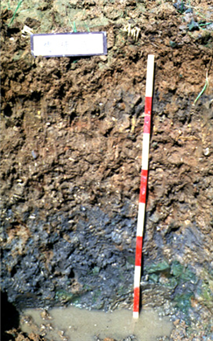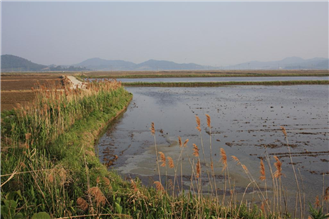

Morphological properties of typifying pedon.
|
|
GUPO SERIES |
Established Series PCS, JYH, UKT 28 Mar., 1977 |
The Gupo series are members of coarse loamy, mixed, nonacid, mesic family of Typic Fluvaquents [Fluvic Gleyic Hydragric Anthrosols (Eutric) classified by WRB]. These soils have thin dark grayish brown loam Ap horizons with yellowish brown mottles and very thick, very dark gray gravelly sandy loam. The Gupo soils are formed on broad fluvio-marine plains derived from fluvio-marine materials with gravels and oyster shell fragments.
Typifying Pedon : Gupo loam-paddy rice (Field description Sacheon Gun Profile No. 15; colors are for moist soil).
Slope: 0-2%
Elevation: m above m.s.l.
Soil moisture regime: Aquic
Temperature regime: Mesic
Parent material: Fluvio-marine deposits
Diagnostic features: An ochric epipedon from a depth of 0 to 15 cm (An anthraquic horizon from a depth of 0 to 43 cm and a hydragric horizon from a depth of 43 to 75 cm by WRB).
|
|
|
|
|
Morphological properties of typifying pedon. |
||
Ap - 0 to 15 cm. Dark grayish brown (2.5YR 4/2) loam; few fine prominent yellowish brown (10YR 5/6) mottles; structureless, massive; friable, slightly sticky and slightly plastic; common fine pores; many fine rice roots; about 6 precent of gravels and shell fragments; clear smooth boundary; pH 7.3.
Cg1 - 15 to 43 cm. Gray (5Y 5/1) gravelly sandy loam; few fine prominent dark yellowish brown (10YR 4/4) mottles; structureless, massive; friable, slightly sticky and slightly plastic; few fine to medium pores; common fine rice roots; about 10 percent of gravels and shell fragments; gradual smooth boundary; pH 7.3.
Cg2 - 43 to 60 cm. Very dark gray (5Y 3/1) gravelly sandy loam; structureless, massive; friable, slightly sticky and slightly plastic; few fine pores; few fine roots; 15 percent of gravels and shell fragments; gradual smooth boundary; pH 7.5.
Cg3 - 60 to 75 cm. Olive gary (5Y 4/2) gravelly sandy loam; structureless, massive; friable slightly sticky and slightly plastic; no pores; no roots; about 20 percent of oyster shell fragments; gradual smooth boundary; pH 8.0.
Cg4 - 75 to 120+ cm. Very dark gray (5Y 3/1) gravelly sandy loam; structureless, massive; consistence, pore, and roots as above; 30 percent of gravels and shell fragments; pH 8.0.
Type Location: Gurang Ri, Seopo Myeon, Sacheon city, Gyeongsangnam Do.
Range in Characteristics: These soils have ochric epipedons. The depth to hard rock is more than 5 meters. Base saturation is more than 60 percent. Reaction is mildly alkaline. This soils have 10 to 35 percent of gravels and shell fragments. Ap horizons are dark grayish brown, grayish brown, light brownish gray, light gray, or gray gravelly loam or sandy loam with few fine yellowish brown or strong brown mottles. The Cg horizons are dark gray, very dark gray, or olive gray gravelly sandy loam or loam.
Competing Series and Their Differentiae: These are the Gwanghwal, Mangyeong, Hamchang, Gimhae and Geumjin series. The Gwanghwal soils are coarse silty texture family and have toxic salt by the sea water. The Mangyeong soils are coarse silty texture. The Hamchang soils are developed on continental alluvial plains. The Gimhae soils are fine silty texture and extremely acid reaction when dry. The Geumjin soils are gravel and shell free.
Setting: The Gupo soils are on level to nearly level fluvio-marine plains derived from stratified coarse textured fluvio-marine materials with gravels and shell fragments, and occur mainly eastern and southern coastal parts of the country. The slope ranges from 0 to 2 percent.
Principal Associated Soils: The Gapo, Gupo, and Dapyeong soils are associated in similar physiographic positions. The Jeonbug, Buyong, and Bongnam soils are associated in continental sides.
Drainage and Permeability: Poorly drained; moderate permeability; ponded or very slow runoff.
Use and Vegetation: Most of these soils are used for paddy rice.
Distribution and Extent: The Gupo soils are of small extent and are distributed on flouvio-marine plains mainly in the eastern and southern coastal parts of the country.
Series Established: Jinyang Gun, Gyeongsangnam Do, 1975.
Laboratory data sheets of typifying pedon.
|
Depth (cm) |
Horizon |
( --- Total ---) |
(-- Clay --) |
(-- Silt --) |
(------- Sand -------) |
||||||||
|
Clay |
Silt |
Sand |
Fine |
Coarse |
Fine |
Coarse |
VF |
F |
M |
C |
VC |
||
|
LT |
.002 |
.05 |
LT |
LT |
.002 |
.02 |
.05 |
.10 |
.25 |
.5 |
1 |
||
|
.002 |
- .05 |
- 2 |
.0002 |
.002 |
- .02 |
- .05 |
- .10 |
- .25 |
- .50 |
- 1 |
- 2 |
||
|
- - - - - - - - - - - Pct of ˂ 2mm (3A1) - - - - - - - - - - - |
|||||||||||||
|
0-14 |
Ap |
19.4 |
24.9 |
|
|
|
|
|
4.3 |
10.6 |
20.5 |
12.6 |
7.7 |
|
14-35 |
Cg1 |
15.0 |
16.8 |
|
|
|
|
|
3.4 |
11.4 |
22.8 |
17.2 |
13.4 |
|
35-60 |
Cg2 |
16.6 |
16.8 |
|
|
|
|
|
3.7 |
11.7 |
21.8 |
17.0 |
12.3 |
|
60-75 |
Cg3 |
17.7 |
21.6 |
|
|
|
|
|
4.3 |
13.2 |
19.7 |
14.5 |
9.0 |
|
75-120+ |
Cg4 |
12.4 |
18.7 |
|
|
|
|
|
4.4 |
13.3 |
22.0 |
15.9 |
13.3 |
|
Depth (cm) |
Coarse Fractions(mm) |
˃2mm |
Orgn |
Total |
Extr |
Total |
(-- Dith -Cit --) |
|||||
|
Weight |
Wt |
C |
N |
P |
S |
Extractable |
||||||
|
2-5 |
5-20 |
20-75 |
.1-75 |
Pct of |
|
|
|
|
Fe |
Al |
Mn |
|
|
|
|
|
|
Whole |
6A1c |
6B3a |
6S3 |
6R3a |
6C2b |
6G7a |
6D2a |
|
|
Pct of ˂ 75mm (3B1) |
Soil |
Pct ˂ 2mm |
g/kg |
Pct of ˂ 2mm |
||||||||
|
0-14 |
|
|
|
|
|
0.67 |
|
|
|
|
|
|
|
14-35 |
|
|
|
|
|
0.25 |
|
|
|
|
|
|
|
35-60 |
|
|
|
|
|
0.23 |
|
|
|
|
|
|
|
60-75 |
|
|
|
|
|
0.41 |
|
|
|
|
|
|
|
75-120+ |
|
|
|
|
|
0.18 |
|
|
|
|
|
|
|
Depth (cm) |
Ratio/Clay |
Atterberg |
( Bulk Density ) |
COLE |
(- Water Content -) |
WRD |
|||||||
|
CEC |
1500 |
Limits |
Field |
33 |
Oven |
Whole |
Field |
10 |
33 |
1500 |
Whole |
||
|
|
kPa |
LL |
PI |
Moist |
kPa |
Dry |
Soil |
Moist |
kPa |
kPa |
kPa |
Soil |
|
|
8D1 |
8D1 |
4P1 |
4P |
4A3a |
4A1d |
4A1h |
4D1 |
4B4 |
4B1c |
4B1c |
4B2a |
4C1 |
|
|
|
|
Pct ˂0.4mm |
- - g/cc - - |
cm/cm |
-- Pct of ˂2mm -- |
cm/cm |
|||||||
|
0-14 |
|
|
|
|
|
|
|
|
|
24.5 |
20.3 |
8.8 |
|
|
14-35 |
|
|
|
|
|
|
|
|
|
19.4 |
16.3 |
7.6 |
|
|
35-60 |
|
|
|
|
|
|
|
|
|
18.9 |
16.1 |
7.5 |
|
|
60-75 |
|
|
|
|
- |
|
|
|
|
25.7 |
18.9 |
8.6 |
|
|
75-120+ |
|
|
|
|
- |
|
|
|
|
16.1 |
13.2 |
6.0 |
|
|
Depth (cm) |
( NH4OAc Extractable Bases ) |
Acid- |
Extr |
(----- CEC -----) |
Al |
||||||
|
Ca |
Mg |
K |
Na |
Sum |
ity |
Al |
Sum |
NH4- |
Bases |
Sat |
|
|
5B5a |
5B5a |
5B5a |
5B5a |
Bases |
|
|
Cats |
OAc |
+ Al |
|
|
|
6N2e |
6O2d |
6Q2b |
6P2b |
|
6H5a |
6G9a |
5A3a |
5A8b |
5A3b |
5G1 |
|
|
- - - - - - - - - - - - meq / 100g - - - - - - - - - - - - |
Pct |
||||||||||
|
0-14 |
8.62 |
3.27 |
0.44 |
1.72 |
|
|
|
|
9.70 |
|
|
|
14-35 |
8.37 |
1.07 |
0.64 |
0.77 |
|
|
|
|
8.70 |
|
|
|
35-60 |
11.37 |
3.27 |
0.70 |
1.95 |
|
|
|
|
8.30 |
|
|
|
60-75 |
8.00 |
4.02 |
1.42 |
2.40 |
|
|
|
|
9.40 |
|
|
|
75-120+ |
8.87 |
3.50 |
1.25 |
2.27 |
|
|
|
|
7.35 |
|
|
|
Depth (cm) |
(Base Sat) |
CO3 as |
Res |
Cond |
(------ pH ------) |
Acid Oxalate Extraction |
|||||||
|
Sum |
NH4- |
CaCO3 |
|
|
NaF |
KCl |
CaCl2 |
H2O |
Opt |
Al |
Fe |
Si |
|
|
|
OAc |
˂2mm |
|
|
|
|
.01M |
|
Den |
|
|
|
|
|
5C3 |
5C1 |
6E1g |
8E1 |
8I |
8C1d |
|
8C1f |
8C1f |
8J |
6G12 |
6C9a |
6V2 |
|
|
---- Pct ---- |
ohms/cm |
dS/m |
|
1: 1 |
1: 2 |
1: 1 |
|
- Pct of ˂2mm - |
|||||
|
0-14 |
|
100 |
|
|
|
|
7.4 |
|
8.1 |
|
|
|
|
|
14-35 |
|
100 |
|
|
|
|
7.6 |
|
8.5 |
|
|
|
|
|
35-60 |
|
100 |
|
|
|
|
7.7 |
|
8.5 |
|
|
|
|
|
60-75 |
|
100 |
|
|
|
|
7.7 |
|
8.6 |
|
|
|
|
|
75-120+ |
|
100 |
|
|
|
|
8.1 |
|
8.6 |
|
|
|
|